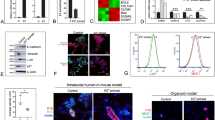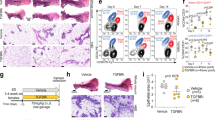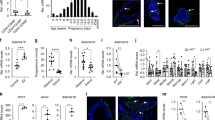Abstract
The ovarian hormones oestrogen and progesterone profoundly influence breast cancer risk1,2,3, underpinning the benefit of endocrine therapies in the treatment of breast cancer4. Modulation of their effects through ovarian ablation or chemoprevention strategies also significantly decreases breast cancer incidence5,6. Conversely, there is an increased risk of breast cancer associated with pregnancy in the short term7. The cellular mechanisms underlying these observations, however, are poorly defined. Here we demonstrate that mouse mammary stem cells (MaSCs)8,9 are highly responsive to steroid hormone signalling, despite lacking the oestrogen and progesterone receptors10. Ovariectomy markedly diminished MaSC number and outgrowth potential in vivo, whereas MaSC activity increased in mice treated with oestrogen plus progesterone. Notably, even three weeks of treatment with the aromatase inhibitor letrozole was sufficient to reduce the MaSC pool. In contrast, pregnancy led to a transient 11-fold increase in MaSC numbers, probably mediated through paracrine signalling from RANK ligand. The augmented MaSC pool indicates a cellular basis for the short-term increase in breast cancer incidence that accompanies pregnancy. These findings further indicate that breast cancer chemoprevention may be achieved, in part, through suppression of MaSC function.
This is a preview of subscription content, access via your institution
Access options
Subscribe to this journal
Receive 51 print issues and online access
$199.00 per year
only $3.90 per issue
Buy this article
- Purchase on Springer Link
- Instant access to full article PDF
Prices may be subject to local taxes which are calculated during checkout



Similar content being viewed by others
Accession codes
Primary accessions
Gene Expression Omnibus
Data deposits
All microarray data are available from the Gene Expression Omnibus database (http://www.ncbi.nlm.nih.gov/geo) under accession codes GSE20401 and GSE20402.
References
Clemons, M. & Goss, P. Estrogen and the risk of breast cancer. N. Engl. J. Med. 344, 276–285 (2001)
Hankinson, S. E., Colditz, G. A. & Willett, W. C. Towards an integrated model for breast cancer etiology: the lifelong interplay of genes, lifestyle, and hormones. Breast Cancer Res. 6, 213–218 (2004)
Pike, M. C., Spicer, D. V., Dahmoush, L. & Press, M. F. Estrogens, progestogens, normal breast cell proliferation, and breast cancer risk. Epidemiol. Rev. 15, 17–35 (1993)
Early Breast Cancer Trialists’ Collaborative Group Effects of chemotherapy and hormonal therapy for early breast cancer on recurrence and 15-year survival: an overview of the randomised trials. Lancet 365, 1687–1717 (2005)
Parker, W. H. et al. Ovarian conservation at the time of hysterectomy and long-term health outcomes in the nurses’ health study. Obstet. Gynecol. 113, 1027–1037 (2009)
Visvanathan, K. et al. American society of clinical oncology clinical practice guideline update on the use of pharmacologic interventions including tamoxifen, raloxifene, and aromatase inhibition for breast cancer risk reduction. J. Clin. Oncol. 27, 3235–3258 (2009)
Lambe, M. et al. Transient increase in the risk of breast cancer after giving birth. N. Engl. J. Med. 331, 5–9 (1994)
Shackleton, M. et al. Generation of a functional mammary gland from a single stem cell. Nature 439, 84–88 (2006)
Stingl, J. et al. Purification and unique properties of mammary epithelial stem cells. Nature 439, 993–997 (2006)
Asselin-Labat, M. L. et al. Steroid hormone receptor status of mouse mammary stem cells. J. Natl Cancer Inst. 98, 1011–1014 (2006)
Anderson, E. & Clarke, R. B. Steroid receptors and cell cycle in normal mammary epithelium. J. Mammary Gland Biol. Neoplasia 9, 3–13 (2004)
Mueller, S. O., Clark, J. A., Myers, P. H. & Korach, K. S. Mammary gland development in adult mice requires epithelial and stromal estrogen receptor alpha. Endocrinology 143, 2357–2365 (2002)
Mallepell, S., Krust, A., Chambon, P. & Brisken, C. Paracrine signaling through the epithelial estrogen receptor alpha is required for proliferation and morphogenesis in the mammary gland. Proc. Natl Acad. Sci. USA 103, 2196–2201 (2006)
Brisken, C. et al. A paracrine role for the epithelial progesterone receptor in mammary gland development. Proc. Natl Acad. Sci. USA 95, 5076–5081 (1998)
Lydon, J. P. et al. Mice lacking progesterone receptor exhibit pleiotropic reproductive abnormalities. Genes Dev. 9, 2266–2278 (1995)
Mulac-Jericevic, B., Lydon, J. P., DeMayo, F. J. & Conneely, O. M. Defective mammary gland morphogenesis in mice lacking the progesterone receptor B isoform. Proc. Natl Acad. Sci. USA 100, 9744–9749 (2003)
Forbes, J. F. et al. Effect of anastrozole and tamoxifen as adjuvant treatment for early-stage breast cancer: 100-month analysis of the ATAC trial. Lancet Oncol. 9, 45–53 (2008)
Visvader, J. E. Keeping abreast of the mammary epithelial hierarchy and breast tumorigenesis. Genes Dev. 23, 2563–2577 (2009)
Lim, E. et al. Aberrant luminal progenitors as the candidate target population for basal tumor development in BRCA1 mutation carriers. Nature Med. 15, 907–913 (2009)
Fernandez-Valdivia, R. et al. Transcriptional response of the murine mammary gland to acute progesterone exposure. Endocrinology 149, 6236–6250 (2008)
Ciarloni, L., Mallepell, S. & Brisken, C. Amphiregulin is an essential mediator of estrogen receptor alpha function in mammary gland development. Proc. Natl Acad. Sci. USA 104, 5455–5460 (2007)
Asselin-Labat, M. L. et al. Gata-3 is an essential regulator of mammary-gland morphogenesis and luminal-cell differentiation. Nature Cell Biol. 9, 201–209 (2007)
Fisher, C. R., Graves, K. H., Parlow, A. F. & Simpson, E. R. Characterization of mice deficient in aromatase (ArKO) because of targeted disruption of the cyp19 gene. Proc. Natl Acad. Sci. USA 95, 6965–6970 (1998)
Lydon, J. P., Sivaraman, L. & Conneely, O. M. A reappraisal of progesterone action in the mammary gland. J. Mammary Gland Biol. Neoplasia 5, 325–338 (2000)
Srivastava, S. et al. Receptor activator of NF-κB ligand induction via Jak2 and Stat5a in mammary epithelial cells. J. Biol. Chem. 278, 46171–46178 (2003)
Fata, J. E. et al. The osteoclast differentiation factor osteoprotegerin-ligand is essential for mammary gland development. Cell 103, 41–50 (2000)
Fernandez-Valdivia, R. et al. The RANKL signaling axis is sufficient to elicit ductal side-branching and alveologenesis in the mammary gland of the virgin mouse. Dev. Biol. 328, 127–139 (2009)
Gonzalez-Suarez, E. et al. RANK overexpression in transgenic mice with mouse mammary tumor virus promoter-controlled RANK increases proliferation and impairs alveolar differentiation in the mammary epithelia and disrupts lumen formation in cultured epithelial acini. Mol. Cell. Biol. 27, 1442–1454 (2007)
Kim, N. S. et al. Receptor activator of NF-κB ligand regulates the proliferation of mammary epithelial cells via Id2. Mol. Cell. Biol. 26, 1002–1013 (2006)
Howell, A. The endocrine prevention of breast cancer. Best Pract. Res. Clin. Endocrinol. Metab. 22, 615–623 (2008)
Hu, Y. & Smyth, G. K. ELDA: Extreme limiting dilution analysis for comparing depleted and enriched populations in stem cell and other assays. J. Immunol. Methods 347, 70–78 (2009)
Dontu, G. et al. In vitro propagation and transcriptional profiling of human mammary stem/progenitor cells. Genes Dev. 17, 1253–1270 (2003)
Gentleman, R. C. et al. Bioconductor: open software development for computational biology and bioinformatics. Genome Biol. 5, R80 (2004)
Ritchie, M. E. et al. A comparison of background correction methods for two-colour microarrays. Bioinformatics 23, 2700–2707 (2007)
Smyth, G. K. Linear models and empirical bayes methods for assessing differential expression in microarray experiments. Stat. Appl. Genet. Mol. Biol. 3, 1–28 (2004)
Ritchie, M. E. et al. Empirical array quality weights in the analysis of microarray data. BMC Bioinform. 7, 261 (2006)
Smyth, G. K., Michaud, J. & Scott, H. S. Use of within-array replicate spots for assessing differential expression in microarray experiments. Bioinformatics 21, 2067–2075 (2005)
Acknowledgements
We are grateful to A. Morcom and T. Ward for technical assistance, T. Bouras for advice, S. Mihajlovic for histology and F. Battye for FACS support. We thank C. Clarke for providing the hPRa7 antibody, A. Burgess for AG1478, A. Parlow for prolactin, and the Australian Genome Research Facility for RNA bioanalyses. M.-L.A.-L. is supported by an Australian Research Council Postdoctoral Fellowship. This work was supported by the Victorian Breast Cancer Research Consortium (J.E.V. and G.J.L.), the National Health and Medical Research Council (Australia), the Susan G. Komen Foundation, the National Breast Cancer Foundation and the Australian Cancer Research Foundation.
Author information
Authors and Affiliations
Contributions
M.-L.A.-L. conceptualized and designed the experiments and performed most of the experiments and data analysis; F.V. performed transplantation experiments and analysis; J.S. performed in vitro inhibitor experiments; B.P. performed quantitative RT–PCR; D.W. and G.K.S. performed bioinformatics analyses; E.R.S. provided ArKO mice and advice; H.Y. provided anti-RANKL inhibitor and advice; T.J.M. provided advice and helped design RANKL experiments; J.E.V. and G.J.L. conceived and directed the study, and J.E.V., G.J.L. and M.-L.A.-L. wrote the manuscript.
Corresponding authors
Ethics declarations
Competing interests
The authors declare no competing financial interests.
Supplementary information
Supplementary Figures
This file contains Supplementary Figures S1-S7 with legends. The Supplementary Tables were added on 14 April 2010. A small correction was made to Supplementary Table 5 on 19 May 2010. (PDF 2300 kb)
Supplementary Table 1
This file contains the gene profiling data (Log2-intensity and the log2-fold-change) for mammary populations from control versus ovariectomized (Ovx) and 12.5 day pregnant mice. (XLS 623 kb)
Rights and permissions
About this article
Cite this article
Asselin-Labat, ML., Vaillant, F., Sheridan, J. et al. Control of mammary stem cell function by steroid hormone signalling. Nature 465, 798–802 (2010). https://doi.org/10.1038/nature09027
Received:
Accepted:
Published:
Issue Date:
DOI: https://doi.org/10.1038/nature09027
This article is cited by
-
Postdiagnosis circulating osteoprotegerin and TRAIL concentrations and survival and recurrence after a breast cancer diagnosis: results from the MARIE patient cohort
Breast Cancer Research (2023)
-
Single-cell transcriptomics provide insight into metastasis-related subsets of breast cancer
Breast Cancer Research (2023)
-
Progesterone from ovulatory menstrual cycles is an important cause of breast cancer
Breast Cancer Research (2023)
-
Hormonal regulation of mammary gland development and lactation
Nature Reviews Endocrinology (2023)
-
Macrophages maintain mammary stem cell activity and mammary homeostasis via TNF-α-PI3K-Cdk1/Cyclin B1 axis
npj Regenerative Medicine (2023)
Comments
By submitting a comment you agree to abide by our Terms and Community Guidelines. If you find something abusive or that does not comply with our terms or guidelines please flag it as inappropriate.



